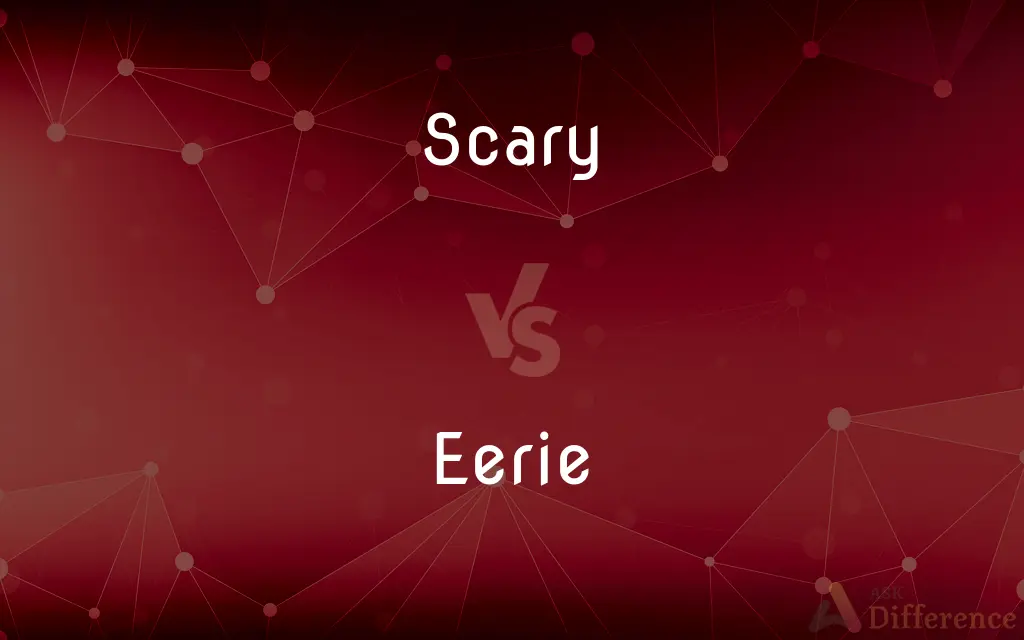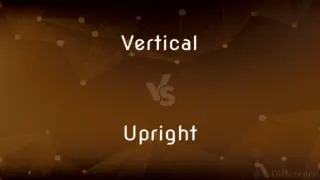Scary vs. Eerie — What's the Difference?
Edited by Tayyaba Rehman — By Maham Liaqat — Updated on April 27, 2024
Scary evokes immediate fear and alarm, often due to a clear, present danger; eerie suggests a subtle, unsettling strangeness or mysteriousness.

Difference Between Scary and Eerie
Table of Contents
ADVERTISEMENT
Key Differences
Scary situations or elements typically involve a direct threat, triggering a strong, instinctive fear response, as seen in horror movies. On the other hand, eerie settings may not pose a direct danger but create a sense of discomfort due to their odd, inexplicable qualities, like an abandoned house at night.
In literature, a scary story might involve explicit threats like monsters or ghosts that are clearly meant to alarm the reader. Whereas, eerie narratives thrive on the unknown and the less obvious, relying on the atmosphere and implications rather than overt horrors.
The emotional response to scary things is usually more intense and immediate, aiming to provoke a visceral reaction such as jumping or screaming. In contrast, eerie experiences often leave a lingering sense of unease, as they subtly disturb rather than shock.
Visual media often use jump scares, sudden loud noises, and intense imagery to create a scary effect. Conversely, eerie visuals might include foggy landscapes, dimly lit corridors, and slow, creeping camera movements that build a haunting atmosphere.
In terms of physical environments, a scary place might be a dark alley known for danger. Meanwhile, an eerie place could be an old, seemingly deserted village that feels as though it's hiding secrets.
ADVERTISEMENT
Comparison Chart
Definition
Causing fright or panic
Strange in a way that causes discomfort
Emotional Response
Immediate and intense fear
Subtle, prolonged unease
Typical Elements
Clear threats (monsters, darkness)
Unclear, odd elements (fog, silence)
Impact on Viewer/Reader
Provokes a visceral reaction
Creates a lingering sense of disturbance
Usage in Media
Jump scares, loud noises
Slow builds, atmospheric tension
Compare with Definitions
Scary
Threatening or menacing.
The dark alley had a scary, forbidding aura.
Eerie
Mysteriously strange or otherworldly.
An eerie silence filled the abandoned hall.
Scary
Alarmingly dangerous.
The steep, scary cliff was daunting to climbers.
Eerie
Inspiring superstitious fear or dread; weird.
There’s an eerie glow coming from the forest at night.
Scary
Full of fear.
The children were scary and crying after hearing the loud noises.
Eerie
Producing a feeling of unease; strange and frightening.
An eerie sound came from the attic.
Scary
Intended to frighten; causing fear.
The scary movie kept us on the edge of our seats.
Eerie
Uncannily unsettling, as if of supernatural origin.
The eerie coincidence left everyone baffled.
Scary
Creepy or spooky.
That scary old mansion looks like a ghost house.
Eerie
Creepy, especially in a desolate or solitary manner.
The eerie abandoned village spooked the visitors.
Scary
Causing fright or alarm.
Eerie
Eerie was an American magazine of horror comics introduced in 1966 by Warren Publishing. Like Mad, it was a black-and-white magazine intended for newsstand distribution and did not submit its stories to the comic book industry's voluntary Comics Code Authority.
Scary
Easily scared; very timid.
Eerie
Inspiring inexplicable fear, dread, or uneasiness; strange and frightening.
Scary
Causing fear or anxiety
The tiger's jaws were scary.
She was hiding behind her pillow during the scary parts of the film.
Eerie
(Scots) Frightened or intimidated by superstition.
Scary
(informal) Uncannily striking or surprising.
Linda changed her hair, and it’s scary how much she looks like her mother.
Eerie
Strange, weird, fear-inspiring, especially in a shadowy or mysterious way.
The eerie sounds seemed to come from the graveyard after midnight.
Scary
Subject to sudden alarm; easily frightened.
Eerie
(Scotland) Frightened, timid.
Scary
(informal) To a scary extent; scarily.
Eerie
An eerie creature or thing.
Scary
Barren land having only a thin coat of grass.
Eerie
Serving to inspire fear, esp. a dread of seeing ghosts; wild; weird; as, eerie stories.
She whose elfin prancer springsBy night to eery warblings.
Scary
Barren land having only a thin coat of grass.
Eerie
Affected with fear; affrighted.
Scary
Subject to sudden alarm.
Eerie
Suggestive of the supernatural; mysterious;
An eerie feeling of deja vu
Scary
Causing fright; alarming.
Eerie
So strange as to inspire a feeling of fear;
An uncomfortable and eerie stillness in the woods
An eerie midnight howl
Scary
So scary as to cause chills and shudders;
The most terrible and shuddery...tales of murder and revenge
Common Curiosities
How do filmmakers use sound to create scary and eerie effects?
Scary effects often use sudden, loud sounds for shocks, while eerie effects use subtle, disturbing sounds to build tension.
Are there cultural differences in what is considered scary vs. eerie?
Yes, cultural backgrounds can influence what individuals find scary or eerie, based on local folklore, historical events, or common fears within the community.
How can architecture evoke a scary or eerie feeling?
Scary architecture might include confined, dark spaces, while eerie architecture features odd, unexpected, or abandoned elements.
Can a place be both scary and eerie?
Yes, if it combines direct threats with a mysterious or strange atmosphere.
Why might someone prefer eerie stories over scary ones?
Some prefer the subtle, lingering unease of eerie stories to the intense shocks of scary stories.
What type of settings are commonly found in eerie stories?
Eerie stories often feature settings like fog-covered landscapes, dimly lit places, or abandoned structures that contribute to a sense of mystery and disquiet.
How do children typically react to scary versus eerie stimuli?
Children are likely to react with overt fear and avoidance to scary stimuli, whereas eerie stimuli might confuse or subtly unsettle them.
What makes something scary rather than eerie?
Scary involves clear, immediate threats, whereas eerie relates to an unsettling strangeness.
What role do soundtracks play in movies to enhance scary and eerie moods?
Soundtracks in movies amplify scary moods with abrupt, loud music or noises, and enhance eerie moods with subtle, dissonant, or minimalistic soundscapes.
Is one emotion stronger than the other—scary or eerie?
It depends on the context and the individual; scary can provoke a stronger immediate reaction, while eerie might leave a deeper, more lasting impression.
How do theme parks use scary and eerie elements differently?
Theme parks use scary elements like sudden drops and fast speeds to elicit screams and thrills, whereas eerie elements are used in haunted houses or ghostly rides to create a creepy, suspenseful environment.
What is the primary emotional response to something that is scary?
The primary response to something scary is immediate and intense fear, often causing a fight-or-flight reaction.
Can animals also experience feelings of eeriness?
While animals can react to immediate threats (scary), it's less clear if they can experience eeriness, which often involves more complex emotional nuances.
Can everyday objects become scary or eerie? How?
Everyday objects can become scary or eerie when placed in unusual contexts or depicted in unexpected ways, like a doll in a horror film or an old, ticking clock in an empty room.
What literary devices enhance the scary or eerie atmosphere in writing?
In writing, scary atmospheres are enhanced by vivid, alarming descriptions and sudden actions, while eerie atmospheres are built with subtle hints, ambiguous descriptions, and slow reveals.
Share Your Discovery

Previous Comparison
Vertical vs. Upright
Next Comparison
Olingo vs. OlinguitoAuthor Spotlight
Written by
Maham LiaqatEdited by
Tayyaba RehmanTayyaba Rehman is a distinguished writer, currently serving as a primary contributor to askdifference.com. As a researcher in semantics and etymology, Tayyaba's passion for the complexity of languages and their distinctions has found a perfect home on the platform. Tayyaba delves into the intricacies of language, distinguishing between commonly confused words and phrases, thereby providing clarity for readers worldwide.
















































